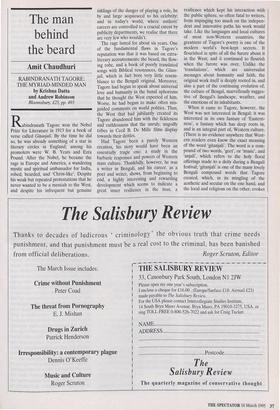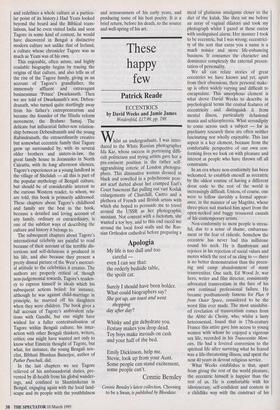The man behind the beard
Amit Chaudhuri
RABINDRANATH TAGORE: THE MYRIAD-MINDED MAN by Krishna Datta and Andrew Robinson Bloomsbury, £25, pp. 493 Rabindranath Tagore won the Nobel Prize for Literature in 1913 for a book of verse called Gitanjali. By the time he did so, he was already something of a star in literary circles in England; among his promoters were W. B. Yeats and Ezra Pound, After the Nobel, he became the rage in Europe and America, a wandering mystic and spiritual ambassador for India, robed, bearded, and 'Christ-like'. Despite his weak but repeated protestations that he never wanted to be a messiah to the West, and despite his infrequent but genuine inklings of the danger of playing a role, he by and large acquiesced to his celebrity: and in today's world, where authors' careers are controlled to a crucial extent by publicity departments, we realise that there are very few who wouldn't.
The rage lasted for about six years. One of the fundamental flaws in Tagore's reputation was that it was based on extra- literary accoutrements: the beard, the flow- ing robe, and a book of poorly translated songs with Biblical resonances, the Gitan- jail, which in fact bore very little resem- blance to the Bengali original. Moreover, Tagore had begun to speak about universal love and humanity in the banal aphorisms that he thought the West expected of him. Worse, he had begun to make often mis- guided comments on world politics. Thus, the West that had jubilantly created its Tagore abandoned him with the fickleness and ruthlessness that the unruly, ungodly tribes in Cecil B. De Mille films display towards their deities.
Had Tagore been a purely Western creation, his story would have been an essentially tragic one: a study in the barbaric responses and powers of Western mass culture. Thankfully, however, he was a writer in Bengali, and his career, as a poet and writer, shows, from beginning to end, a highly interesting and rewarding development which seems to indicate a great inner resilience in the man, a resilience which kept his interaction with the public sphere, so often fatal to writers, from impinging too much on the indepen- dent and innovative paths his work would take. Like the languages and local cultures of most non-Western countries, the greatness of Tagore's poetry is one of the modern world's best-kept secrets. It flourished in spite of all the furore about it in the West; and it continued to flourish when the furore was over. Unlike the `translations', which are universalist messages about humanity and faith, the original work itself is deeply rooted in, and also a part of the continuing evolution of, the culture of Bengal, marvellously sugges- tive of Bengal's landscape, weather, and the emotions of its inhabitants.
When it came to Tagore, however, the West was not interested in Bengal; it was interested in its own fantasy of 'Eastern- ness', a fantasy which has deep roots in, and is an integral part of, Western culture. (There is no evidence anywhere that West- ern readers even know the exact meaning of the word `gitanjale. The word is a com- pound of two words, `geet', or 'music', and `anjali', which refers to the holy floral offerings made to a deity during a Bengali festival; `gitanjali' is one of the many lovely Bengali compound words that Tagore created, which, in its mingling of the aesthetic and secular on the one hand, and the local and religious on the other, evokes and redefines a whole culture at a particu- lar point of its history.) Had Yeats looked beyond the beard and the Biblical trans- lations, had he even visited India and seen Tagore in some kind of context, he would have discovered in Bengal a distinctive modern culture not unlike that of Ireland, a culture whose chronicler Tagore was as much as Yeats was of his own.
This enjoyable, often astute, and highly readable biography begins by tracing the origins of that culture, and also tells us of the rise of the Tagore family, giving us an account of Tagore's grandfather, the immensely affluent and extravagant businessman 'Prince' Dwarkanath. Then we are told of Dwarkanath's son, Deben- dranath, who turned quite startlingly away from his father's entrepreneurism and became the founder of the Hindu reform movement, the Brahmo Samaj. The delicate but influential father son relation- ship between Debendranath and the young Rabindranath, the extraordinarily creative but somewhat eccentric family that Tagore grew up surrounded by, with its several older brothers and sisters-in-law, the great family house in Jorasanko in North Calcutta, with its long afternoon silences, Tagore's experiences as a young landlord in the village of Shelidah — all this is part of the popular mythology of Bengali culture, but should be of considerable interest to the curious Western reader, to whom, we are told, this book is primarily addressed. These chapters about Tagore's childhood and family are the best in the book, because a detailed and loving account of any family, ordinary or extraordinary, is one of the subtlest ways of describing the culture and history it belongs to.
The subsequent chapters about Tagore's international celebrity are painful to read because of their account of the terrible dis- tortions and self-delusions it produced in his life, and also because they present a pretty dismal picture of the West's mercuri- al attitude to the celebrities it creates. The authors are properly critical of, though non-judgemental towards, Tagore's tenden- cy to express himself in ideals which his subsequent actions belied: for instance, although he was against child-marriage in principle, he married off his daughters when they were children. The book gives a full account of Tagore's ambivalent rela- tions with Gandhi, but one might have wished for a fuller contextualisation of Tagore within Bengali culture; his inter- action with other Bengali thinkers, writers, critics; one might have wanted not only to know what Einstein thought of Tagore, but what, for instance, the young. Bengali nov- elist, Bibhuti Bhushan Banerjee, author of Father Panchali, did.
In the last chapters we see Tagore relieved of his ambassadorial duties, pre- vented by ill-health from his global wander- ings, and confined to Shantiniketan in Bengal, engaging again with the local land- scape and its people with the youthfulness and sensuousness of his early years, and producing some of his best poetry. It is a brief return, before his death, to the source and well-spring of his art.



























































 Previous page
Previous page